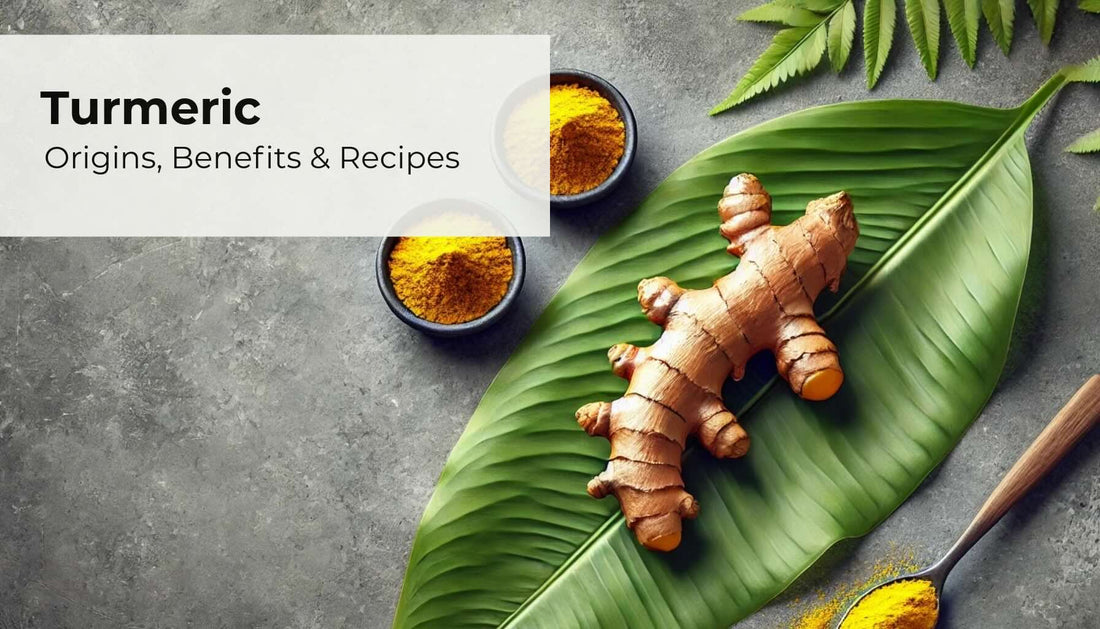
Turmeric: Origins, Benefits and Recipes
Share
Table of Contents
- History of Turmeric
- Cultural Significance and Spread
- Trade and Economic Impact
- An Intriguing Story: The Golden Milk Tradition
- Health Benefits of Turmeric
- High Confidence Benefits
- Moderate Confidence Benefits
- Early Stage Benefits
- Recommended Consumption
- How to Grow Turmeric
- Popular Recipes with Turmeric
- Golden Milk (Turmeric Latte)
- Turmeric Rice
- Curried Lentil Soup
- Conclusion
1. History of Turmeric
Turmeric, scientifically known as Curcuma longa, is a flowering plant of the ginger family, Zingiberaceae. Its use dates back over 4,000 years to the Vedic culture in India, where it was initially used as a dye due to its intense yellow-orange hue. The ancient Indian medical system, Ayurveda, also recognized turmeric's medicinal properties. It was used in a variety of formulations to treat a range of ailments from respiratory issues to digestive disorders.
Archaeological findings suggest that turmeric was part of the Harappan civilization (circa 3300-1300 BCE) in the Indus Valley. It was not just a spice but a significant element in their religious and cultural practices, symbolizing purity, fertility, and prosperity.
1.1 Cultural Significance and Spread
Turmeric's use began in ancient Indian and Southeast Asian cultures. It was a staple in Indian cuisine, contributing to the distinctive yellow color of many traditional dishes such as curries and rice preparations. Beyond the kitchen, turmeric played a significant role in religious rituals and traditional medicine. The spice was used in ceremonies, including weddings and other significant life events, where it symbolized purity and auspiciousness.
As trade routes developed, turmeric spread to other regions, including the Middle East and Africa. By the time of the medieval period, it had reached China and Africa, and from there, it continued its journey to Europe through the spice trade. In Europe, it was initially valued more for its dyeing properties than its culinary uses. However, over time, European traders and explorers began to recognize its potential in cooking and medicine.
1.2 Trade and Economic Impact
Today, India remains the largest producer and exporter of turmeric, accounting for approximately 80% of the world's supply. The spice is predominantly grown in states like Andhra Pradesh, Tamil Nadu, Karnataka, Odisha, and West Bengal. Other significant producers include Pakistan, China, Haiti, Jamaica, Peru, and Thailand.
The global market for turmeric was valued at around $3.3 billion in 2020 and is projected to grow due to increasing awareness of its health benefits. The spice's trade volume is substantial, with millions of kilograms exported annually to meet global demand. The increasing popularity of natural health supplements and the rise in consumer awareness about the benefits of turmeric have significantly contributed to its economic impact.
1.3 An Intriguing Story: The Golden Milk Tradition
One fascinating tradition involving turmeric is the ancient practice of consuming "golden milk" or "haldi doodh." This drink, made by mixing turmeric with milk and other spices, has been used for centuries in Indian households to treat colds, inflammation, and other ailments. Golden milk is typically prepared by boiling milk with turmeric, black pepper, and sometimes ginger and honey. This age-old remedy, passed down through generations, is known for its soothing properties and ability to boost immunity.
In recent years, this traditional drink has gained international popularity. "Turmeric lattes," a modern twist on golden milk, are now featured in cafes worldwide. This reflects a blend of ancient wisdom and modern trends, bringing a traditional Indian remedy into the global spotlight.

2. Health Benefits of Turmeric
Turmeric's health benefits are primarily attributed to its active compound, curcumin. Extensive research has explored curcumin's potential in various health areas. Here, we categorize these benefits based on the level of scientific confidence and evidence backing them. There are a lot of strong claims from articles out there, its important to understand how confident science is in validating some of these claims as you make health decisions. And please, talk to a Dr before making any health related decisions.
2.1 High Confidence Benefits
- Anti-inflammatory Properties: Chronic inflammation is a known contributor to many common Western diseases, including heart disease, cancer, and Alzheimer’s. Curcumin is a bioactive substance that fights inflammation at the molecular level. Its effectiveness has been compared to some anti-inflammatory drugs, without the side effects. Research consistently supports curcumin’s role in reducing inflammation, making it one of the most reliable benefits of turmeric.
- Antioxidant Benefits: Curcumin is a powerful antioxidant that can neutralize free radicals due to its chemical structure. Additionally, curcumin boosts the activity of your body's own antioxidant enzymes, providing a two-fold effect against oxidative stress. This dual action helps to protect the body from damage caused by free radicals, which is well-documented in scientific literature.
- Arthritis Management: Given its anti-inflammatory properties, curcumin can help manage arthritis symptoms. Several studies have shown that curcumin supplements can reduce symptoms of arthritis and are, in some cases, more effective than anti-inflammatory drugs. A study published in Phytotherapy Research found curcumin to be effective in reducing joint pain in patients with osteoarthritis.
- Brain Health and Cognitive Function: Curcumin has been shown to cross the blood-brain barrier and has been studied for its potential to improve cognitive function and reduce the risk of neurodegenerative diseases. It may help by reducing inflammation and oxidative damage, both of which play a role in conditions like Alzheimer’s disease. Although this area of research is promising, it is still developing, with some studies showing more definitive results than others.
2.2 Moderate Confidence Benefits
- Cardiovascular Health: Curcumin may help improve heart health by enhancing the function of the endothelium, the lining of your blood vessels. Endothelial dysfunction is a major driver of heart disease. Some studies suggest that curcumin leads to improvements in endothelial function, a measure of how well your blood vessels are able to dilate and contract. However, more large-scale studies are needed to confirm these effects consistently.
- Cancer Prevention: Curcumin has been studied extensively as a cancer-fighting agent. It can influence cancer growth, development, and spread at the molecular level. Studies have shown that it can reduce angiogenesis (the growth of new blood vessels in tumors), metastasis (spread of cancer), and contribute to the death of cancerous cells. While animal and test-tube studies have shown promising results, human studies are still in the early stages.
- Depression and Mental Health: Curcumin has shown potential in treating symptoms of depression. One study published in Phytotherapy Research found that curcumin was as effective as Prozac in treating major depressive disorder without the side effects commonly associated with antidepressants. While initial results are promising, more extensive clinical trials are necessary to firmly establish curcumin’s effectiveness in treating depression.
- Diabetes Management: There is evidence that curcumin can improve insulin sensitivity and help manage blood sugar levels, which are critical in managing diabetes. However, while animal studies and small human trials have shown positive outcomes, more research is needed to confirm these benefits in larger human populations.
2.3 Early Stage Benefits
- Skin Health: Some studies suggest that curcumin might help with skin health, including conditions like psoriasis and acne, due to its anti-inflammatory and antioxidant properties. However, these claims are primarily based on small-scale studies or anecdotal evidence, and more robust clinical trials are needed.
- Weight Loss: There are claims that curcumin can aid in weight loss and reduce the incidence of obesity-related diseases. While some studies show a potential benefit, the evidence is not yet strong enough to make definitive claims. More research is required to understand the mechanisms and effectiveness of curcumin in weight management.
- Digestive Health: Curcumin has been traditionally used to treat various digestive issues, including indigestion and bloating. Preliminary research supports its role in promoting gut health, but more comprehensive studies are needed to confirm these benefits conclusively.
By categorizing turmeric’s health benefits based on the level of scientific confidence, we can better understand which claims are strongly supported and which require further research. Incorporating turmeric into your diet using easy-to-measure amounts like teaspoons and tablespoons can help you enjoy its robust flavor and numerous well-supported health benefits.
2.4 Recommended Consumption
To reap the health benefits of turmeric, a daily intake of about 500 to 2,000 milligrams of curcumin is recommended. This is roughly equivalent to one teaspoon of ground turmeric powder. It's important to note that curcumin has low bioavailability, meaning it's not easily absorbed by the body. Consuming it with black pepper, which contains piperine, can enhance absorption by up to 2,000%. Additionally, incorporating turmeric into your diet with healthy fats like olive oil or coconut oil can also improve absorption.
3. How to Grow Turmeric

Growing turmeric at home can be a rewarding experience, allowing you to have a fresh supply of this valuable spice. Here’s a step-by-step guide on how to grow turmeric:
- Choosing Rhizomes: Start with fresh turmeric rhizomes (roots) which can be purchased from health food stores or online. Select rhizomes that are plump and free of any mold or soft spots.
- Preparing the Soil: Turmeric thrives in well-drained, fertile soil rich in organic matter. Use a mix of potting soil, compost, and sand to create an ideal growing medium. Ensure the soil pH is slightly acidic to neutral (5.5 to 7.0).
- Planting: Plant the rhizomes in a pot or directly in the garden, about 2-4 inches deep, with the buds facing upwards. Space them about 12 inches apart to give each plant room to grow.
- Watering: Keep the soil consistently moist but not waterlogged. Water the plants regularly, especially during dry periods. Turmeric prefers a humid environment, so misting the plants can help if you live in a dry area.
- Sunlight: Turmeric requires a warm and sunny location. It grows best in temperatures between 68°F and 95°F. If you’re growing it indoors, place it near a sunny window where it can receive indirect light.
- Fertilizing: Feed the plants with a balanced organic fertilizer every few weeks. This will provide the necessary nutrients to support healthy growth.
- Harvesting: Turmeric takes about 8-10 months to mature. Once the leaves and stems start to dry and turn brown, it’s time to harvest. Carefully dig up the rhizomes, rinse off the soil, and let them dry in a cool, shaded area.
- Storage: Fresh turmeric can be stored in the refrigerator for a few weeks. For longer storage, you can dry the rhizomes and grind them into powder or freeze them for later use.
Growing your own turmeric ensures you have a fresh supply of this potent spice, which can be easily measured with measuring spoons for cooking or health preparations.
4. Popular Recipes with Turmeric
Incorporating turmeric into your diet is easy, and it adds a warm, earthy flavor to dishes. Here are a few popular recipes:
4.1 Golden Milk (Turmeric Latte)

- Ingredients: 1 teaspoon turmeric powder, 1 cup milk (dairy or plant-based), 1/4 teaspoon black pepper, 1/2 teaspoon cinnamon, 1 teaspoon honey.
- Instructions: Heat the milk in a saucepan, add the spices and honey, and whisk until well combined. Serve warm.
- Benefits: This drink is a soothing remedy for colds and inflammations and can be easily measured using a teaspoon.
4.2 Turmeric Rice

- Ingredients: 1 cup basmati rice, 1 teaspoon turmeric powder, 2 cups water, 1 tablespoon ghee or olive oil, salt to taste.
- Instructions: Rinse the rice and add it to a pot with water, turmeric, ghee, and salt. Bring to a boil, then simmer until the rice is cooked and fluffy.
- Benefits: Turmeric rice is a staple in many South Asian dishes, providing an easy way to incorporate turmeric into your diet with a tablespoon of ghee for better absorption.
4.3 Curried Lentil Soup

- Ingredients: 1 cup red lentils, 1 onion (chopped), 2 cloves garlic (minced), 1 teaspoon turmeric powder, 1 teaspoon cumin powder, 1 can coconut milk, 4 cups vegetable broth.
- Instructions: Sauté the onion and garlic in oil, add the spices, lentils, broth, and coconut milk. Simmer until the lentils are tender.
- Benefits: This hearty soup is packed with nutrients and is easy to measure out the dry spices with a teaspoon and tablespoon.
5. Conclusion
Turmeric is more than just a spice; it's a symbol of health and tradition with a rich history that spans millennia. From ancient rituals to modern research, turmeric continues to prove its worth in the culinary and medicinal worlds. By incorporating turmeric into your diet using easy-to-measure amounts like teaspoons and tablespoons, you can enjoy its robust flavor and numerous health benefits. Stay tuned for the next post in this series, where we will explore the wonders of cinnamon and its unique contributions to health and culture.









